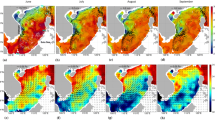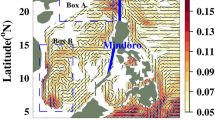Abstract
In this work, the National Center for Environmental Prediction/ National Center for Atmospheic Research (NCEP/ NCAR) global daily–mean reanalysis data are used to diagnose the features of the local circulation variation during the South China Sea (SCS) monsoon in 1998. It is found that by taking the appearance of southwest wind in lower layers and east wind in upper layers as the sign of the monsoon onset, the SCS monsoon starts on May 25 in 1998, which is later than that in normal years. The formation of the SCS monsoon is not a simple propagation of southwest monsoon in the north—south direction, but a process in which the southwest wind starts first over the north of the SCS, withdraws southward, and then propagates from south to north again. During this process, both meteorological elements and circulation fields change significantly. The outbreak of the SCS monsoon is the result of the seasonal variation of the height in lower and upper layers. The air rounding the Tibetan Plateau might be one of the dynamic reasons that make the summer monsoon start over the SCS at first. At the different stages of the monsoon, the vertical circulations as well as the lower and the upper layer divergence fields undergo evident temporal and regional changes. The SCS monsoon has the 60–day, 20–30–day and 8–15–day low frequency oscillations (LFOs), and dominant scale changes at the different stages of monsoon. The monsoon onset is related to the superimposition of the amplitudes of LFOs with different scales.
Similar content being viewed by others
References
Hu, Z. Z., and W. Shi, 1997: Application study of wavelet transform in atmospheric sciences. Scientia Atmospherica Sinica, 21(1), 58–72 (in Chinese).
Jiang, N. B., and H. B. Luo, 1995: The first transition of the circulation in Asia around mid-May from 7-year mean ECMWF data. Journal of Tropical Meteorology, 11(4d), 289–296 (in Chinese).
Tao, S. Y., and L. X. Chen, 1987: A review of recent research of the East Asian summer monsoon in China. Monsoon Meteorology, Oxford University Press, 60–92.
Wu, G. X., and Y. S. Zhang, 1998: Tibetan Plateau forcing and the timing of the monsoon onset over South Asia and the South China Sea. Monthly Weather Review, 126(4), 913–927.
Author information
Authors and Affiliations
Additional information
Sponsored by the National Key Project of Fundamental Research SCSMEX
Rights and permissions
About this article
Cite this article
Hui, S., Yongfu, Q. Main features of regional circulation variation during onset of the south china sea monsoon in 1998. Adv. Atmos. Sci. 17, 322–338 (2000). https://doi.org/10.1007/s00376-000-0013-x
Received:
Revised:
Issue Date:
DOI: https://doi.org/10.1007/s00376-000-0013-x




